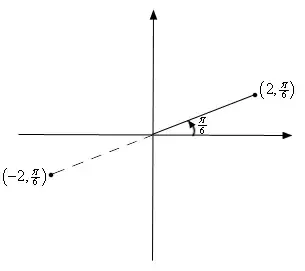I have 4 questions regarding the imaginary and complex numbers. (And some ideas)
My questions are about the way that I’m trying to come up with a proof to the equation i²=-1 (and from there maybe also the equation sqrt(-1)=i or -i) without of course first accepting them to be true axiomatically.
I would like to hear your ideas! The following is not any kind of proof itself, but just some ideas that I am having and I would like to know if they are correct or not and what are your ideas about them.
We start by having 2 axes, one for the real numbers and one (at right angles to it) for the imaginary ones, forming the complex plain. But because we have not defined any complex numbers yet we should better avoid naming it "complex plain" just yet.
xx' axes are the axes of the real numbers
yy' axes are the axes of the imaginary numbers
*(note 1: we should not call "i" or any other imaginary number, "imaginary" yet. At least not before proving them to be so)
*(note2: angles are measured counterclockwise from the x’x axes)
I will first take i and give this new definition where: i=1<90° (or i=(1,90°))
1) i=1<90°
That notation means that i is a number on top of a vector with a length of 1 unit and 90° degrees angle counterclockwise from the x’x axes.
I will also take -1 and make it a vector on my complex plain. -1 of course is a number on a vector with 180° of angle from the x’x axes and a length of 1 unit. Therefore -1 can be written as a vector of (1<180°). This can also be written as -1=(1,180°) but I'll just stick with the complex polar form for the rest of this approach.
*(note3: the symbol < means "angle" by the way)
2) -1=1<180°
Then I will proceed on squaring this new i number.
Squaring i will also square the vector (1<90°) and we all know that squaring this vector in polar form equals to ( 1*1 < 90°+90° ) which equals to (1<180°)
i²=(1<90°)² =>
i²=(1*1 <90°+90°) =>
i²=(1<180°)
Therefore I ended up with this equation i²=(1<180°)
3) i²=(1<180°)
i² therefore is a new number upon our new vector (1<180°) that has a length of 1 and an angle of 180° counterclockwise from the xx' axes
Using (2) We know that -1=1<180°
So squaring the i, will lead us upon the real number -1
So to recap the whole thing we did:
i²=(1<90°)² => Step 1
i²=(1*1 < 90°+90°) => Step 2
i²=(1<180°) => using (2) Step 3
i²=-1 Step 4
sqr(-1)=±i ??? Step 5
And here are my 4 questions:
1) Is it correct to go from step 1 to step 2 ?
2) Can we therefore prove that i²=-1 from the 3rd step i²=(1<180°) ?
3) Can we then say that from i²=-1 we can get to sqr(-1)=±i step 5 ?
4) And even further, can we then define the imaginary and complex numbers and base their new definitions (and maybe the whole ℂ) in this new equation i=1<90° instead of this i²=-1 or ±i=sqr(-1) equation?
Main goal for me is to get a better understanding on the whole concept of imaginary numbers, and I have to be honest with you, that the way I was introduced in school to the imaginary numbers and being told that people just accepted this idea just because it worked is not the best way, the already open mind of a student, to be introduced in complex analysis and beyond.
Are imaginary numbers created or invented? A 'meaning' can mean a lot of things, but most importantly a 'meaning' in mathematics is a way to logically connect 2 and more things together and see how they cooperate. Algebra and geometry for example.
You name it!
Thanks for your time.
